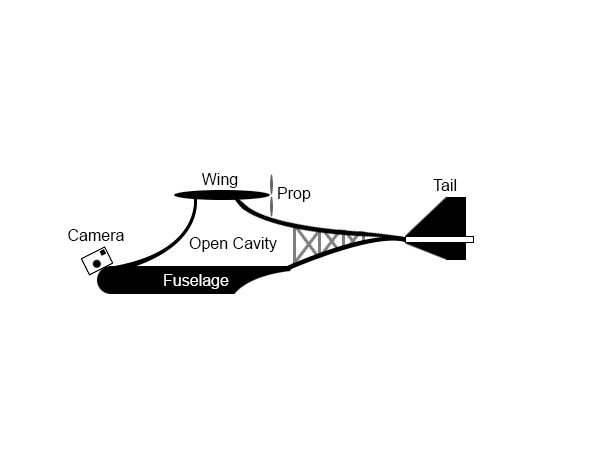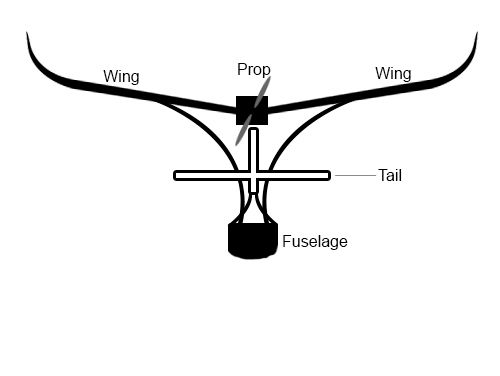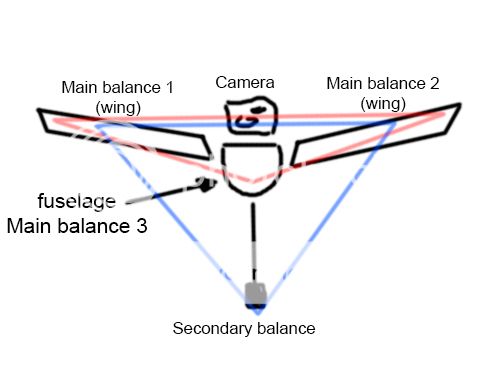Dane
Junior Member
Low Fuselage for FPV Stability
Notice: Excuse my crudeness, I am not very technical. I apologize in advance if you read it and please don't laugh at me! Just brainstorming stability solutions
Notice 2: I've pretty much scrapped the idea of the secondary weight. But I still like the idea of the lowered fuselage.
The Idea: To lower the fuselage further below the wings, to improve stability, create a nice platform and view for FPV rig. The wings and tail would be attached to the main fuselage with carbon fiber rods, or another material, that wouldn't increase wind-resistance from other directions (Like a crosswind)
Excuse my bad drawings, wacom tablet is broken.
Maybe this will make more sense? Very rough idea.


__________________________________________________
Original Post:
This is really geared mostly towards high altitude FPV and improved stabilization. The idea is simple: A controlled, low-hanging weight to balance out uncontrollable forces (wind, mostly). I know there are some systems out there that make minute auto-adjustments to your ailerons and such to counter any outside forces, but what if we reduced them at the source, instead of after the fact?
I got the idea from home-made steady camera systems which incorporates 1 balance to either side, and a camera mounted on top. A very stable triangle. Like depicted in image 1:

Now with a plane, we already have 2 factors stabilizing either side of the camera, the wings... so where is our third point of stability? The fuselage weight and position. But the fuselage can only extend so low for aerodynamic purposes (maybe I am wrong, I am assuming) So this is essentially, an upside-down homemade steady-cam, with the camera position replaced with a weight, and the camera is placed between the 2 main balances (wings)
Image 2:

Now I think a static weight would only do so much ... You could float around straight, and do some basic rudder movements... but any bank maneuvers would perhaps defeat the purpose of the system. I propose that the system be controlled, such that when it banks, the system would move the secondary weight appropriately.
Image 3:

These movements couldn't be made such that X amount of ailerons = X amount of "secondary balance" shift.. because if that worked... Then you are already such a perfect flier that you wouldn't need this stability. The system would have to be operated with some kind of gyro, which kept the "secondary balance" pointed towards the ground at all times (at least in my head)
But who knows... as stated, I am no engineer, and maybe a static weight WOULD work, since the center mass is being pushed outwards on a bank turn...... and maybe a plane like this with a low-hanging fuselage would work!

It could look really cool, have plenty of space for the fpv to move around, the prop could be in front or behind the wings. It sounds nice.
Things to consider:
1. Top speed in relation to flexability of material used to extend weight below fuselage. Pendulum effect is the last thing you would want.
2. Landing with this junk hanging off the bottom (maybe a retractable system?)
3. Weight of the secondary balance in relation to its distance.
If anything, I hope that this will spark some kind of conversation about stability... whether my idea is useful or not.
Thanks for reading and happy sailing,
-Dane
Notice: Excuse my crudeness, I am not very technical. I apologize in advance if you read it and please don't laugh at me! Just brainstorming stability solutions
Notice 2: I've pretty much scrapped the idea of the secondary weight. But I still like the idea of the lowered fuselage.
The Idea: To lower the fuselage further below the wings, to improve stability, create a nice platform and view for FPV rig. The wings and tail would be attached to the main fuselage with carbon fiber rods, or another material, that wouldn't increase wind-resistance from other directions (Like a crosswind)
Excuse my bad drawings, wacom tablet is broken.
Maybe this will make more sense? Very rough idea.


__________________________________________________
Original Post:
Spoiler!
This is really geared mostly towards high altitude FPV and improved stabilization. The idea is simple: A controlled, low-hanging weight to balance out uncontrollable forces (wind, mostly). I know there are some systems out there that make minute auto-adjustments to your ailerons and such to counter any outside forces, but what if we reduced them at the source, instead of after the fact?
I got the idea from home-made steady camera systems which incorporates 1 balance to either side, and a camera mounted on top. A very stable triangle. Like depicted in image 1:

Now with a plane, we already have 2 factors stabilizing either side of the camera, the wings... so where is our third point of stability? The fuselage weight and position. But the fuselage can only extend so low for aerodynamic purposes (maybe I am wrong, I am assuming) So this is essentially, an upside-down homemade steady-cam, with the camera position replaced with a weight, and the camera is placed between the 2 main balances (wings)
Image 2:

Now I think a static weight would only do so much ... You could float around straight, and do some basic rudder movements... but any bank maneuvers would perhaps defeat the purpose of the system. I propose that the system be controlled, such that when it banks, the system would move the secondary weight appropriately.
Image 3:

These movements couldn't be made such that X amount of ailerons = X amount of "secondary balance" shift.. because if that worked... Then you are already such a perfect flier that you wouldn't need this stability. The system would have to be operated with some kind of gyro, which kept the "secondary balance" pointed towards the ground at all times (at least in my head)
But who knows... as stated, I am no engineer, and maybe a static weight WOULD work, since the center mass is being pushed outwards on a bank turn...... and maybe a plane like this with a low-hanging fuselage would work!

It could look really cool, have plenty of space for the fpv to move around, the prop could be in front or behind the wings. It sounds nice.
Things to consider:
1. Top speed in relation to flexability of material used to extend weight below fuselage. Pendulum effect is the last thing you would want.
2. Landing with this junk hanging off the bottom (maybe a retractable system?)
3. Weight of the secondary balance in relation to its distance.
If anything, I hope that this will spark some kind of conversation about stability... whether my idea is useful or not.
Thanks for reading and happy sailing,
-Dane
Attachments
Last edited:

